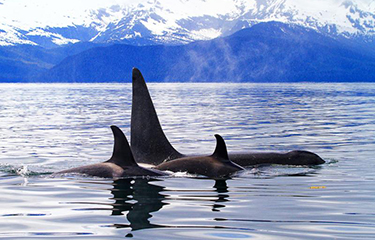NOAA Fisheries has released more information from its investigation of the death of 10 killer whales off the coast of Alaska, as well as the serious injury of an eleventh whale.
“Given the high level of incidental catches of killer whales in 2023, we knew it was important to move as quickly as possible to better understand whether these incidental takes pose a conservation concern to any of the potentially affected killer whale stocks,” Alaska Fisheries Science Center Director Robert Foy said. “As a result, we expedited processing and some procedures to complete genetic analysis as samples were received to provide some preliminary information on stock-specific impacts of these mortalities.”
All but one of the whales was caught up in commercial trawling gear.
“The number of incidental takes is higher than previous years,” NOAA Fisheries explained. “However, it is still below the annual level that would pose a risk to the long-term health for any of the three killer whale stocks found in the region where the incidental takes occurred.”
NOAA Fisheries’ “Potential Biological Removal” estimate, a calculation of the maximum number of animals that can be removed while maintaining the optimum sustainable populations, for the Eastern North Pacific Alaska Resident killer whale is 19 whales. All eight of the whales that observers were able to collect biological samples from were from the Eastern North Pacific Alaska Resident killer whale stock.
Most of the killer whales were caught by commercial fishing vessels using non-pelagic trawl gear targeting flatfish. Six of the whales were killed by the fishing gear, while two were dead prior to being caught. A ninth whale was seriously injured but released alive.
A tenth dead whale was caught by a commercial pollock fishing vessel using pelagic trawl gear. NOAA Fisheries determined that the whale was dead before encountering the fishing gear.
An eleventh whale was killed after being entangled in survey gear during the Alaska Fisheries Science Center’s annual longline survey for sablefish and groundfish.
“This was the first observed killer whale mortality in the 30-year history of this survey,” NOAA Fisheries said of the incident.
The agency said that it will continue to analyze the impact of the deaths on the killer whale stock and plans to release a technical memo with more data on all reported killer whale entanglements from 1991 to 2022.
The Groundfish Forum, a trade association whose members were involved in some of the encounters, reported that it is seeing killer whales more frequently around commercial fishing operations and was changing its operations to better avoid the animals.
“Our fleet is committed to finding solutions to this unprecedented challenge,” the Groundfish Forum said. “We have invested in research activities to better understand the change in killer whale behavior and how to avoid them. Vessels are experimenting with gear modifications that may prevent whales from entering the net.”
In response to the deaths, the Center for Biological Diversity filed notice of its intent to sue NOAA Fisheries for failing to protect marine mammals from groundfish trawling operations.
“I’m deeply disturbed by how blatantly the trawl fisheries are harming marine mammals like orcas and destroying the health of the entire Bering Sea ecosystem,” Center for Biological Diversity Alaska Representative Cooper Freeman said in October. “The federal government’s job is to protect imperiled marine animals and their habitats, but it’s massively failing in the Bering Sea. Officials need to act now to stop the carnage and bring this out-of-control fishery into compliance with the law.”
Photo courtesy of NOAA Fisheries







